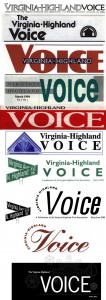What I learned about VaHi from old Voice newsletters
 by Brian Gross, Communications Committee
by Brian Gross, Communications Committee
I recently helped scan and uploaded more than 60 past issues of the Virginia-Highland Voice, the VHCA’s long-standing paper newsletter, which continues today in electronic form. The issues ranged from the very first Voice in 1972 through 1976, then a large gap, and then other issues dating from 1988-2012.
By scanning headlines I was able to create online tables of contents for each issue. In doing so I read many articles and I thought I’d share with you the most interesting articles I found. Keep in mind I’m a relative newcomer (3 years) – and I know that others might find other topics more interesting than I do. Also, I know there is always more to the story than what I found. I speak for myself here and not for the VHCA. With those disclaimers, here’s what I found interesting:
Neighborhood Empowerment and Fighting I-485
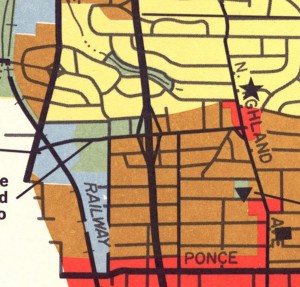
Planned route of I-485 through VaHi
The Voices from the 70s don’t actually give the full background and context of the battle that raged at the time against the building of the I-485 freeway north-south through Virginia-Highland and other neighborhoods.
Nor do they discuss the fact that this was the first time neighborhoods actually had a voice – “the third leg of the stool” in the city, next to business and the black community.
But it is interesting to catch these glimpses of that time, once I was educated on the context and history.
One article also explained the very real problem of redlining at that time – something that until recently I only thought happened in minority areas. (Voices from 1972 – 1973 – 1974 – 1975 – 1976)
Sidewalks
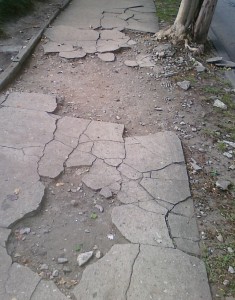
The most intractable problem in VaHi?
Virginia-Highland’s broken sidewalks? “Always and forever” an issue… examples:
- 2005 “Worst Stretch of Sidewalk” Photo Contest.
- 2004 “Fix Your Sidewalk!”
- 2003 Sidewalk Repair Assistance
- 1993: Sidewalks are in for a Facelift
Zoning
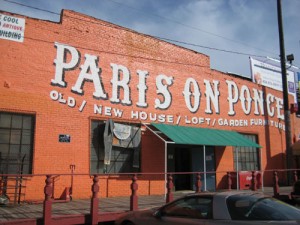
Almost a 2000-person mega-entertainment complex?
The VHCA battled some projects that would have been disastrous and might have led us to become a second Buckhead village (where violence from partygoers got so bad they tore the place down!):
- A mega-entertainment complex for 2000 people, the largest in the city, on the site of the Colgate Mattress warehouse, what is today Paris on Ponce – including a lawsuit against a board member
- A 700-person-capacity “Cotton Club” at the Hilan Theatre (the building that most recently housed Ben and Jerry’s)
- The demolition of 780 N. Highland (today’s Glamour Paws) to make way for a parking structure
But, the association lost the battle to save dozens of majestic oak trees at 830 Ponce, the site today of The Carlton on Ponce condominiums.
Ponce de Leon Avenue
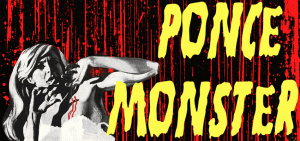 In 1990 a “Ponce Taskforce” was formed, and the Fall 1990 issue was dedicated to Ponce, inventorying the help organizations there, the transient hotels, and the problems. In 1992 there was a spirited letter to the editor against a potential expansion of Grady Hospital onto Ponce.
In 1990 a “Ponce Taskforce” was formed, and the Fall 1990 issue was dedicated to Ponce, inventorying the help organizations there, the transient hotels, and the problems. In 1992 there was a spirited letter to the editor against a potential expansion of Grady Hospital onto Ponce.
Ponce has improved substantially since then I am sure, but is still a problem. I feel that as a community we “face” north, west and east, but turn our back to Ponce. Is the community too exhausted to try and improve it?
Summerfest and Tour of Homes
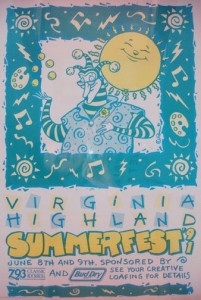 Summerfest is present in nearly every issue, Tour of Homes almost as often, and every year the plans were announced and the ever-greater successes described. Some articles that stood out:
Summerfest is present in nearly every issue, Tour of Homes almost as often, and every year the plans were announced and the ever-greater successes described. Some articles that stood out:
- Two “looks back” at Summerfest: in 2005: a look back at Summerfest 1975; in 2008: Warren Bruno’s look back
- In 1993, “the fate of Summerfest” would be decided – smaller? larger? Move it from John Howell Park?
Safety
Of course, John Wolfinger’s Safety Reports are legendary, but were not included in the hard copy Voice because of John’s desire to have the reports distributed by street captains, thereby strengthening that program.
As the person who drove the 2010 expansion of FBAC (member supported security patrol) to cover the entire neighborhood, I found it interesting to read about a spirited, but unsuccessful effort to do so in 1994, as well as to track how FBAC came to be.
Parks and Trees
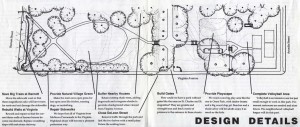
John Howell Park 1988 original plan
Some standout articles:
- 2001: A nostalgic history of how John Howell Park came to be
- 1995: John Howell Park was to acquire an AIDS memorial sculpture by the same artist who did the Iwo Jima Memorial in Washington, D.C. (Money ran out to do this…)
- In 1990, we wanted the property at St. Charles (near Bonaventure), that had been cleared to built I-485, to be turned into a children’s playground. I think housing is there now.
- The 1988 original plans for John Howell Park were interesting.
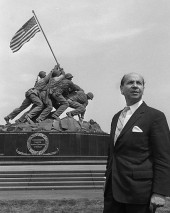
His work was to grace VaHi
The tireless efforts of Stephanie Coffin to save trees and plant more are a red thread throughout almost all Voice issues.
Retail
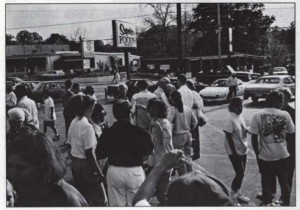
Superior Foods closes, 1994
- In 1994, residents were shocked by the sudden closing of Superior Foods grocery, where CVS is today on N. Highland.
- Recently a friend from Vinings asked me if I enjoyed all the galleries in VaHi. I was baffled – what galleries? Now I understand – she hadn’t been to VaHi for a long time! In 1993, VaHi was famous for art galleries – I enjoyed this overview of them.
- In 1994 VaHi was coffee and dessert-obsessed – I enjoyed the comparison of seven locations. Why are there no dedicated dessert places today!?
People
Portraits of exceptional neighborhood volunteers and organizers:
- Warren Bruno (multiple articles)
- 2004: Cynthia Gentry, who led efforts to build the Cunard Playground at John Howell Park
- 1993: Ed Neal
- 1988: John Howell
And honorable mention to indefatigable columnists:
- Nan Hunter’s recycling columns in the 1990s when recycling was a new idea
- The Highland Ho-er (gardening tips by today’s safety guru John Wolfinger)
- Colonel Mustard (restaurant reviews)
PS – Some of the ads were very entertaining too, such as this 1990 Murphy’s ad:
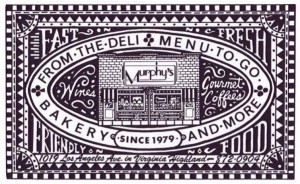
Ad for Murphy's, Virginia-Highland Voice, August 1990
